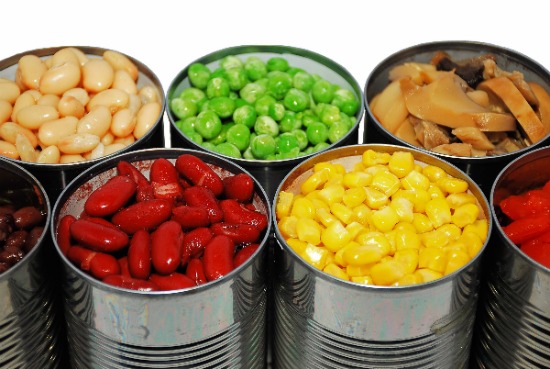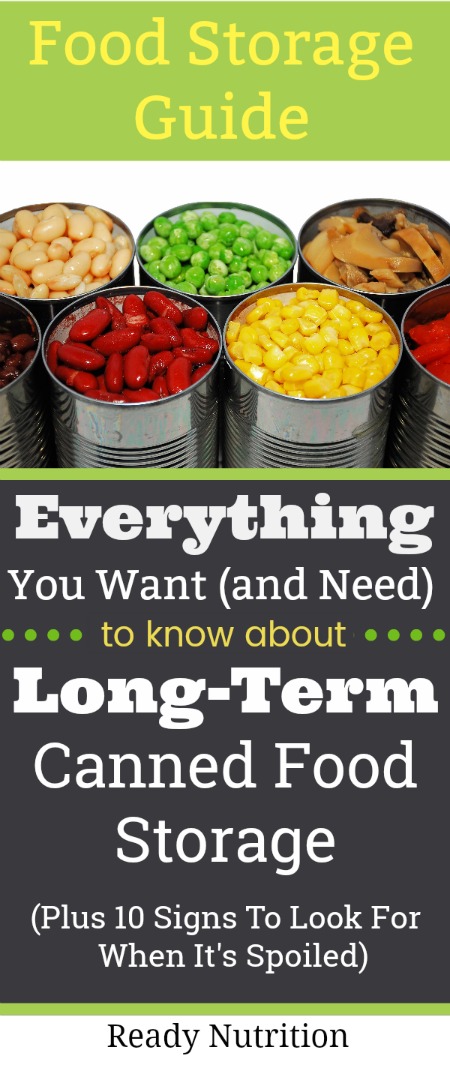
You’ve likely got a nice supply of canned goods in your pantry and food storage inventory, but how long do those products truly last?
Will they still be safe to eat when a disaster arises and you need to start popping those cans open and consuming their contents?
“Best by”, “sell by”, “use by”, “best before”, and expiration dates are all terms used on food packaging, and they are often a source of confusion.
Here’s what those commonly used terms actually mean, according to the USDA:
- A “Best if Used By/Before” indicates when a product will be of best flavor or quality. It is not a purchase or safety date.
- A “Sell-By” date tells the store how long to display the product for sale for inventory management. It is not a safety date.
- A “Use-By” date is the last date recommended for the use of the product while at peak quality. It is not a safety date except for when used on infant formula as described below.
Regarding infant formula, the USDA elaborates:
Federal regulations require a “Use-By” date on the product label of infant formula under inspection of the U.S. Food and Drug Administration (FDA). Consumption by this date ensures the formula contains not less than the quantity of each nutrient as described on the label. Formula must maintain an acceptable quality to pass through an ordinary bottle nipple.
The “Use-By” date is selected by the manufacturer, packer or distributor of the product on the basis of product analysis throughout its shelf life, tests, or other information. It is also based on the conditions of handling, storage, preparation, and use printed on the label. Do not buy or use baby formula after its “Use- By” date.
In other words, the only items required by federal law to be labeled for expiration are infant formula and some baby foods. All of the other labels you see on foods have been placed there voluntarily by manufacturers.
Unless a use-by or best-by label is followed by the words “for safety,” these dates refer to the quality of your product. There’s no need to panic if you’re a few days past the use-by date.
Dating is for quality, not safety. However, if a calendar date is used, it must express both the month and day of the month (and the year, in the case of shelf-stable and frozen products). If a calendar date is shown, immediately adjacent to the date must be a phrase explaining the meaning of that date, such as “sell by” or “use before.
According to WebMD, “The actual term “Expiration Date” refers to the last date a food should be eaten or used. Last means last — proceed at your own risk.” Expiration dates are rarely found on canned food.
Companies use these labels to protect the reputation of their products, which makes sense – they want consumers to see and consume their food when it is as fresh as possible.
There is no standardized rule that determines which types of products get best-by, use-by, and sell-by stamps. Food manufacturers conduct their own shelf-life studies and indicate the quality timeline of their products based on that data.
Even though there is no uniform or universally accepted system used for food dating in the United States, the dating of some foods is required by more than 20 states. Some states also mandate pulling dairy from store shelves on the expiration date.
Unfortunately, dates on labels often mislead consumers into thinking food magically becomes dangerous to consume on those dates – resulting in a lot of perfectly good food being tossed into the trash.
Understanding that the dates applied to food are for quality and not for safety can help you avoid wasting food – and your money. Keep in mind that regardless of the date, you should always evaluate the quality of a food product prior to eating it.
If you’ve opened the product already, the dates no longer mean much. Once you open a can or package, things become a little less precise because the food is at risk of being contaminated by you or the environment. This is something the date on the packaging can’t account for. Some product labels provide timelines for consumption after opening – look for phrasing like “After opening, use within 7 days.”
Smell and taste can be good indicators of contamination, but are not foolproof: organisms that cause food poisoning are invisible and don’t always cause odors and other obvious signs of trouble.
Here are some additional things to know about canned food.
What do those cryptic codes on canned goods mean?
Each canned food manufacturer has a unique coding system, as the Canned Food Alliance explains:
Some manufacturers list day, month and year of production, while other companies reference only the year. These codes are usually imprinted on the top or bottom of the can. Other numbers may appear and reference the specific plant manufacturing or product information and are not useful to the consumers. If you have specific questions about a company’s product, most manufacturers offer a toll-free number to call for questions about canned food expiration dates.
These codes are primarily for tracking purposes. All food companies in the US are required to follow a strict Food Safety Plan which includes continuous monitoring of food safety functions:
The codes you see on the top/bottom of a food can dictate many tracing items which potentially include Plant Location, Production Line within that Plant, Lot Codes Related to the Food Producers Food Safety Scheme, Supplier of Food Ingredients, Country of Origin of Food Ingredients, Production Date, and Possibly the Can Manufacturer.
How long do canned foods last?
The answer to this question depends on where the food was canned.
Was the food canned at home (your home, or someone else’s)? Or, was it canned at a commercial factory?
Commercially canned food can last several years past the expired dates printed on the cans. According to the Canned Food Alliance, “The general rule of thumb is that canned food has a shelf life of at least two years from the date of purchase.” Writing your purchase date on canned good labels is one way you can track this yourself.
While it can retain its safety and nutritional value well beyond two years, canned food may have some variation in quality, such as a change of color and texture, beyond that time frame. “In fact, canned food has an almost indefinite shelf life at moderate temperatures (75° Fahrenheit and below),” according to the Canned Food Alliance.
Home canned foods are another story. We usually advise readers to use home canned goods within 12 months of the canning date, but the storage life can be prolonged by many years if they remain sealed and stored properly.
Dangers of Improperly Canned Foods
A danger all canned foods pose is from the Clostridium botulinum bacteria, which causes botulism. You cannot see, smell, or taste botulinum toxin – but taking even a small bite of food containing this toxin can be deadly. Most cases in the United States come from home-canned vegetables, reports the CDC:
From 1996 to 2014, there were 210 outbreaks of foodborne botulism reported to CDC. Of the 145 outbreaks that were caused by home-prepared foods, 43 outbreaks, or 30%, were from home-canned vegetables. These outbreaks often occurred because home canners did not follow canning instructions, did not use pressure canners, ignored signs of food spoilage, or didn’t know they could get botulism from improperly preserving vegetables.
The CDC recommends boiling all home-canned foods for 10 minutes before consumption to reduce the risk of infection.
Outbreaks are rare, but the botulinum toxin is generally considered to be the most poisonous substance in the world, and one gram could kill as many as 10 million people. A few years ago, we shared the tragic story of Mike O’Connell, a man who took shortcuts when canning some elk meat and became infected with botulism. Despite proper diagnosis and administration of an anti-toxin, O’Connell became paralyzed. He had extensive rehab and was eventually able to walk again with the aid of a cane.
What is the best way to store canned food?
Proper storage of home-canned foods can help you reduce the risk of serious illness. Store home-canned foods for recommended times only. After preparing safely, label and date the jars and store them in a clean, cool, dark place. For best quality, store between 50°F and 70°F. Can no more food than you will use within one year unless directions for a specific food give other advice. The National Center for Home Food Storage Preservation provides more detailed guidance here: Storing Home Canned Foods.
Store commercially canned food at 50 to 70 degrees Fahrenheit in a dry, dark place. Humidity can speed up deterioration. The FDA notes that taste, aroma, and appearance of food can change rapidly if the air conditioning fails in a home or warehouse.
Canned food as old as 100 years has been found in sunken ships and was found to be still microbiologically safe! Now – we certainly don’t recommend keeping canned goods for 100 years, but this is a powerful example of how well canning can preserve food.
The best way to avoid canned food spoilage is to rotate your food stores. Do an inventory check every 6 months to make sure that canned goods, preserves, and other storage items are within their expiration dates. When organizing food reserves, place the item that has the earliest expiration date in the front so that it is used first. FIFO is a well-known acronym used in the restaurant business. It means, “First In, First Out.” This is a great acronym to use when organizing food storage and is the best way to have the freshest foods available in the event that a long-term disaster occurs.
How to tell if your canned food is safe for consumption
If you are concerned your canned goods have expired, the best way to test them is to use your senses.
How does it look? How does it smell? Do you hear anything when you open the cans?
Before you open a store-bought or home-canned food, inspect the can for contamination.
Suspect contamination if the can is leaking, has bulges, is swollen, or looks damaged or cracked. If you think the food might be contaminated, do not open the can – toss it in the garbage.
Even cans that look fine on the outside might have contaminated food inside. Suspect contamination if the can spurts liquid or foam when you open it, and if the food inside is discolored, moldy, or smells bad.
Obviously, cans bulging with bacteria growth should be discarded, no matter when it was canned at home or what the manufacturer’s expiration date says.
Here are 10 signs your canned food has gone bad:
- Bulging
- Streaking
- Hissing
- Bubbling
- Leaking
- Rusted
- Discolored
- Dented/Damaged
- Smells
- Looks Moldy
Remember: When in doubt, toss it out!

This article was originally published at Ready Nutrition™ on August 6th, 2018






